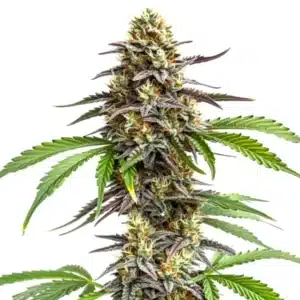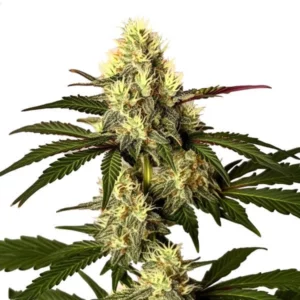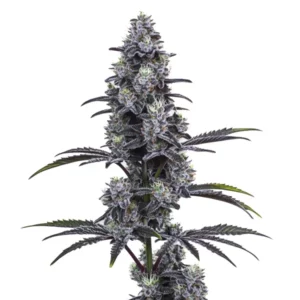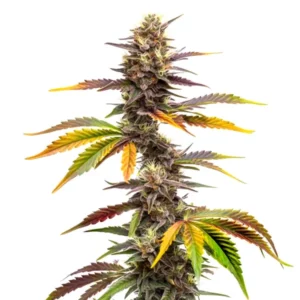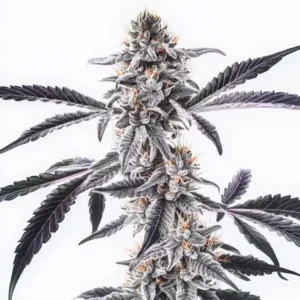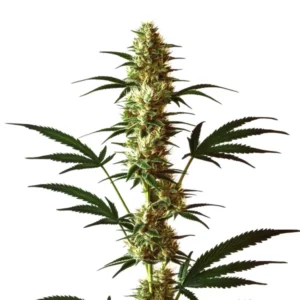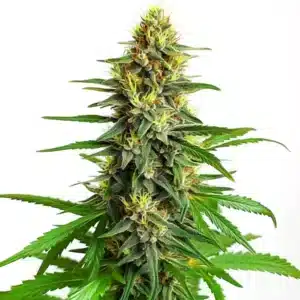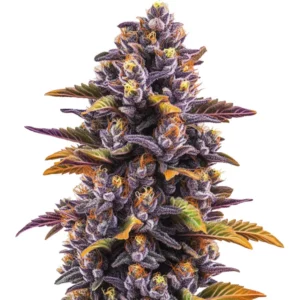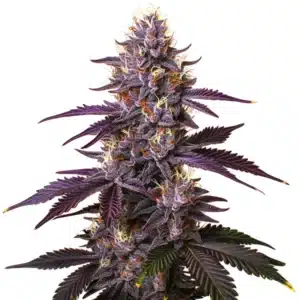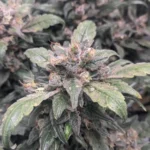
Farnesene Terpene: Benefits and Uses
Farnesene is a terpene commonly found in a variety of plants such as apples, ginger, and cannabis. Known for its crisp, fruity scent, often compared to green apples, it stands out for its potential calming and soothing effects. As a sesquiterpene, farnesene is made up of three isoprene units, giving it unique chemical properties that contribute to its distinctive aroma and potential therapeutic benefits.
Farnesene Terpene is a little-known and elusive cannabis terpene. This terpene produces a distinctive fruity aroma, most notably like green apple peel. Some also describe it as having a woody citrus scent with hints of tropical fruit. Farnesene encompasses six nearly identical chemical compounds. Several plants, including those in the potato family, produce Farnesene, which is believed to function as an insect repellent.
Recommended Strains
What Does Farnesene Do?
In plants, the farnesene terpene plays a crucial role in survival. Acting as a natural pesticide, certain compounds are produced when insects feed on plants, repelling and deterring other pests. These substances can disrupt the pheromone responses and olfactory systems of certain bugs, making the plants less attractive or palatable to them.
Some of these compounds not only repel pests but also attract pollinators and predators of herbivores. Ants, for example, are drawn to specific plant-emitted chemicals, aiding in seed dispersal as they transport seeds while foraging. This mutualistic relationship helps plants to survive and propagate.
Additionally, plants can mimic insect warning signals to enhance their defenses. For instance, aphids release signals when threatened, prompting others to flee. Plants imitate this mechanism to deter insect attacks.
These natural chemicals are also components of the floral scents of roses, gardenias, and orchids, contributing to their characteristic fragrances. They play a significant role in the maturation of fruits and flowers.
Much like an immune system, plants produce phytoalexins—antimicrobial and antioxidant compounds that protect against pathogens. Some of these serve to defend against fungal and bacterial infestations.
When plants suffer extensive damage from herbivores, they release signals to alert other parts of the plant or neighboring plants to bolster their defenses.This can result in the production of chemicals that make the plant less palatable or the release of toxins to fend off predators. Farnesene is like ocimene, another infochemical involved in plant defense mechanisms.
Promos & Deals
Farnesene Terpene Effects
While farnesene is not the most prevalent terpene in cannabis, it is found in numerous strains renowned for their calming effects. This compound is also present in chamomile, a tea celebrated for its sleep-inducing qualities. The connection between this element and soothing effects is not coincidental; its presence in these plants contributes to their ability to help reduce stress and promote relaxation. Studies suggest that its calming properties may stem from the ability to modulate the body’s endocannabinoid system, a complex network that plays a key role in regulating mood, sleep, and stress response.y’s endocannabinoid system, a complex network that plays a key role in regulating mood, sleep, and stress response.
Health Benefits of Farnesene Terpene
Farnesene terpene is not only a pleasant-smelling compound with sedative and insect repellent effects, but it also plays a valuable role in natural health products. Its therapeutic potential includes anti-microbial and anti-fungal properties, enhancing its use in topical applications and as a natural preservative, supporting holistic wellness.

Improves Gut Health
This terpene may play a crucial role in reducing harmful bacteria and enhancing overall gut health. Moreover, it can alleviate bowel cramps, spasms, and painful flatulence. It is also effective in reducing inflammation in the bowels, which can be extremely painful. The anti-spasmodic effects make it a potential natural remedy for those suffering from irritable bowel syndrome (IBS) and other related conditions. Its ability to enhance the intestinal barrier function further promotes a healthy gut microbiome, which is essential for overall health and well-being.
Anti-inflammatory Properties
Farnesene terpene exhibits significant anti-inflammatory properties, but it’s essential to be aware of potential side effects. This makes it useful in treating conditions associated with chronic inflammation, such as arthritis, asthma, and inflammatory bowel diseases. By modulating inflammatory pathways and reducing the production of inflammatory cytokines, farnesene can help to relieve pain and swelling, offering a natural alternative to conventional anti-inflammatory medications.
Neuroprotection
Oxidative stress, caused by an imbalance of free radicals and antioxidants, can severely damage many cells, particularly neurons. Fortunately, farnesene terpene has shown effectiveness in reducing oxidative stress. As an antioxidant, it scavenges free radicals, reducing neuron loss in various neurodegenerative diseases and inhibiting cell death, thereby minimizing damage.
Specifically, in Alzheimer’s disease, this terpene has proven to be an effective neuroprotectant. It reduces neuronal damage caused by beta-amyloid toxicity and necrotic cell death. The potential to improve cognitive functions and slow the progression of neurodegenerative disorders opens new avenues for research and treatment options.
Reduces Anxiety
Farnesene terpene also possesses sedative properties, which contribute to its anxiolytic effects. These calming effects are particularly beneficial for individuals dealing with anxiety disorders. By promoting relaxation and reducing anxiety, this compound can help improve the quality of life for those affected. This can make it a valuable component in treatments aimed at managing anxiety and stress without the side effects often associated with pharmaceutical anxiolytics.
What Does Farnesene Terpene Taste Like?
The flavor profile of the farnesene terpene is not particularly strong or easily recognizable. This compound generally enhances the flavors of other terpenes, esters, and alcohols by adding slightly sweet and herbal notes.
Often described as lightly floral, woody, and sometimes faintly fruity, its taste can vary with concentration. In higher amounts, it can develop a perfumey or soapy quality. Some individuals might also experience a slightly peppery or spicy sensation at the back of the mouth.
It’s worth noting that there are two common isomers that exhibit subtle differences in flavor. One tends to be more herbal and floral, while the other is typically woodier and sweeter.

Cannabis Varieties Rich in Farnesene
What causes marijuana varieties or cultivars to possess distinct and potent aromas, spanning from fruity to skunky, is the composition of their terpenes. Cannabis strains particularly abundant in farnesene encompass.
Blue Headband Strain
Blue Headband is a predominantly Indica-dominant hybrid strain, resulting from the crossbreeding of Blueberry, OG Kush, Sour Diesel, and Pre-98 Bubba. Despite retaining a minimal Sativa influence, its effects lean predominantly towards the Indica side of the spectrum. This strain boasts a pungent diesel aroma with subtle sweet berry undertones, courtesy of Blueberry, while Pre-98 Bubba contributes a spicy touch. The levels of Farnesene Terpene in this genetic strain are exceptional, enhancing its aromatic profile and boosting its therapeutic effects.
Users have reported a significant decrease in stress and anxiety levels when using this strain. Additionally, it is credited with pain relief and an overall sense of relaxation. It’s important to note that heavy use may result in numbing sensations, even for experienced users. Blue Headband offers a complete sensory experience, from its distinctive aroma to its therapeutic effects, making it a popular choice for those seeking effective relief and an elevated mood.
White Rhino Strain
The cannabis strain White Rhino derives its name from its appearance during harvest, characterized by short, stout growth and thick hairs resembling rhinoceros’ horns. It boasts abundant trichomes, resulting in a white coating on its leaves when ready for harvest. Notably, White Rhino contains significant levels of the farnesene terpene, contributing to its distinct earthy and woody flavor with skunky undertones.
While only one parent, the hybrid White Widow, is known, it is speculated that a North American Indica strain contributes to its genetic makeup. With THC levels averaging between 18-22%, White Rhino is considered potent, primarily recommended for evening use due to its profoundly relaxing effects. Users report a sedating high that alleviates stress and induces a numbing body sensation, likened to the force of a rhinoceros, often leading to dizziness or a need for rest.
Common side effects include dry mouth, while its compact stature makes it a favored choice for indoor cultivation, offering high yields.
Zookies Strain
Zookies is a hybrid marijuana strain resulting from the crossbreeding of Animal Cookies and Original Glue. It yields a well-balanced experience, combining potency with delectable flavors. This strain boasts a one-of-a-kind terpene profile, emanating a sweet, nutty cookie aroma with subtle hints of diesel. Zookies is an ideal option for those seeking a robust high without the risk of couchlock.
One notable aspect of Zookies genetics is the presence of the farnesene terpene, which enhances its distinctive aroma and flavor profile. Farnesene terpene, renowned for its aromatic properties and potential therapeutic benefits, is found in significant concentrations in this cannabis variety, adding a unique dimension to the user experience.
With THC levels ranging from 23–25%, Zookies isn’t for the faint-hearted. Upon indulging in Zookies, its potent effects are nearly instantaneous, delivering a sustained high that begins with a calming effect on the mind before enveloping the body, providing a profoundly soothing experience. Zookies is favored among recreational cannabis users for its ability to induce relaxation and happiness, making it the ideal choice for unwinding after a long day or week. Whether shared amongst friends for a laid-back afternoon of movie-watching or enjoyed solo, Zookies promises to usher in a sense of ease, preparing you for a tranquil evening.
For those seeking relief from ailments, Zookies serves as a remedy for winding down and promoting sleep, particularly when consumed in the evening. Additionally, medical users report heightened appetite and potential alleviation from chronic pain symptoms.
FAQs about Farnesene Terpene
What is the Farnesene Terpene and Its Benefits?
Farnesene terpene is a natural compound found in cannabis and various plants. It is known for its fruity, woody aroma and potential therapeutic effects. Farnesene terpenes may help with relaxation, stress relief, and inflammation reduction. Additionally, they interact with the endocannabinoid system, which plays a role in mood and sleep regulation.
Are There Any Farnesene Terpene Side Effects?
Farnesene terpene side effects are minimal, but some users may experience mild drowsiness or relaxation. This terpene is generally well-tolerated, though individual reactions can vary. It is often found in calming cannabis strains and chamomile. If trying a strain high in farnesene, start with a small amount to assess how it affects your body and overall well-being.
What Cannabis Strains Contain High Levels of Farnesene Terpenes?
Strains rich in farnesene terpenes include Blue Headband, White Rhino, and Zookies. These strains are known for their relaxing and therapeutic effects, making them ideal for stress relief. Farnesene terpene contributes to their fruity and woody aromas, enhancing their overall experience. These cannabis varieties are popular among users seeking relaxation and mood enhancement.


